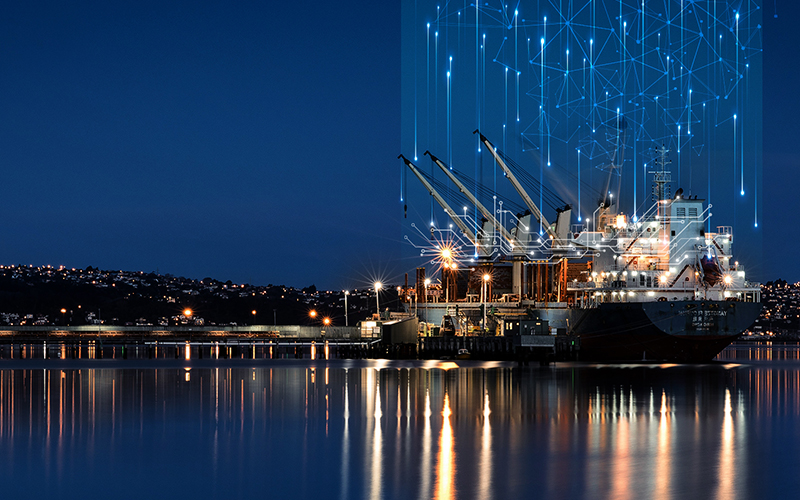The maritime industry is undergoing a profound transformation. What was once a sector defined by legacy communications, intermittent data access, and operational silos is now entering a new era. This new era is shaped by autonomous systems, real-time compliance, AI-enhanced decision-making, and a fundamental shift in how vessels connect to the digital world.
Across this evolving landscape, a consistent trend is emerging: Satellite connectivity is no longer just a tool for crew welfare or occasional data bursts. It is now a cornerstone of mission-critical operations. At the heart of this evolution is the demand for performance, security, and reliability that only next-generation Low Earth Orbit (LEO) constellations are designed to meet enterprise-grade demands.
Regulatory compliance is driving connectivity requirements
Regulatory bodies are increasingly linking digital transparency to environmental accountability. Recent updates to emissions and fuel monitoring regulations, such as the International Maritime Organization’s (IMO) Data Collection System, now require vessels to collect and transmit detailed operational data at regular intervals. These mandates have considerable commercial implications. Non-compliance can result in fines, denied port entry, and lost revenue in key trade lanes.
Meeting these mandates requires more than onboard sensors. It calls for a resilient, always-available communications link that can transmit data securely from vessels operating far from terrestrial coverage. In many cases, port authorities and emissions regulators now expect vessels to send data mid-voyage, with real-time validation. Compliance is now dependent on digital infrastructure.
For fleet operators, the implications are significant. Investing in digital monitoring platforms is only effective if paired with network capabilities that can support automated reporting, data synchronization, and secure access for third-party verification tools. Connectivity is no longer a peripheral consideration. It is foundational to compliance, sustainability, and operational integrity.
Automation and autonomy require low latency and high uptime
Autonomous shipping pilot projects and R&D initiatives are also proving that next-gen technologies need next-gen satellite connectivity. For example, in Europe and Asia, pilot programs are testing connected, crew-reduced, and fully autonomous vessels for coastal and port-to-port operations. These trials rely on integrated systems of onboard sensors, AI-powered navigation, and remote-control interfaces.
Critically, they also depend on communications networks with round-trip latency under 50 milliseconds and assured availability in both high-traffic and remote ocean zones. The bandwidth and responsiveness requirements of time-sensitive applications far exceed what traditional satellite architectures were designed to deliver.
For operators exploring reduced-crew or remotely supervised vessels, latency is not just a metric. It directly impacts operational safety and the ability to make effective decisions, and where autonomy can be deployed with confidence. The network must be as intelligent and reliable as the vessel systems it supports.
In addition, an EU-funded project called the Waterborne Federated Systems and Models for Secure and Resilient (WARRaNT) project is investigating how AI, digital twins, and smart mobility systems can support the next generation of sustainable, autonomous, and connected vessels. This effort brings together 14 leading organizations from eight countries to make autonomous vessels safe, secure, and resilient.
A shift toward hybrid, application-aware architectures
To meet the growing range of operational needs, maritime connectivity is evolving into a multi-layered, software-defined service. Recent deployments combine multiple satellite bands, orbits, and terrestrial pathways into flexible architectures that can adapt in real time to application demands.
This is particularly evident in the rise of platforms that allow vessels to route traffic dynamically across satellite and cellular links based on cost, priority, or bandwidth availability. Whether optimizing fuel usage, delivering high-quality video for crew services, or synchronizing operational databases, vessels now require application-aware networks that can dynamically and intelligently orchestrate data flows.
These developments also underscore the importance of integration. Networks must interact not only with sensors and terminals, but also with fleet management systems, logistics platforms, and third-party analytics applications. The ability to embed connectivity within broader enterprise IT environments and telecom networks is quickly becoming a baseline expectation.
Cybersecurity moves to the forefront
As bandwidth increases and vessels become more digitally integrated, the cybersecurity threat surface also expands. Maritime operators face a growing volume of threats, from phishing and ransomware to unauthorized access of operational systems. The attack surface is widening with every new sensor, control panel, and connected application.
Leading service providers and maritime cybersecurity firms are responding with layered defenses: endpoint monitoring, network segmentation, Zero-Trust Architectures, and real-time threat intelligence. But protection is not purely a technical challenge. It also depends on how the underlying communications architecture is designed, deployed, and monitored.
The expectation is shifting from “secure enough” to “security-first.” This is particularly true in regulated or high-value sectors such as offshore energy, government-chartered transport, and coastal surveillance. Connectivity providers must now demonstrate not just uptime and performance, but a proactive security posture.
Preparing for a more demanding maritime future
Across all elements of these accelerating trends of compliance, autonomy, hybrid architecture, and cybersecurity, a common need emerges: the maritime sector demands a communications infrastructure that is flexible, secure, and built for enterprise-scale operations.
Telesat Lightspeed is uniquely positioned to help maritime customers meet this need. The system is designed with global Layer 2 networking capabilities, allowing seamless integration with enterprise WANs. It features optical inter-satellite links and digital payloads that create a flexible, resilient mesh network in space, ensuring vessels can maintain consistent connections even in polar regions and during intense network loads. With proactive cybersecurity operations and an architecture backed by stringent service level agreements (SLAs) for latency, jitter, and packet loss, Telesat Lightspeed meets the requirements for digital transformation and automation.
By aligning technical capabilities with strategic imperatives such as emissions compliance and autonomous operations, Telesat offers a future-proof solution that goes beyond connectivity. It empowers maritime stakeholders to navigate complexity, optimize performance and profitability, and lead with innovation.
The seas may be vast and challenging. But with the right partner in orbit, smarter shipping through automation can go from a distant vision to a reality.



